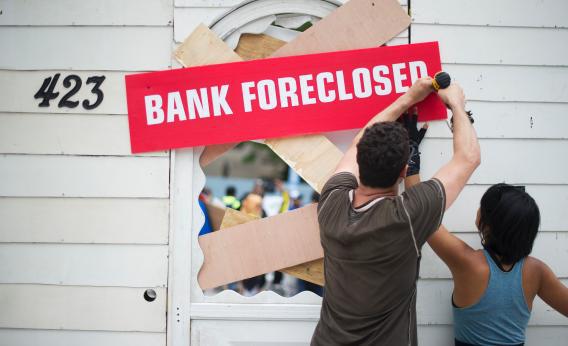The idea of using eminent domain powers to try to help out underwater homeowners has been widely discussed (here, for example) but according to Shaila Dewan it’s Richmond, Calif., that’s finally going to try to pull the trigger.
The basic idea is that you’ve got a family that took out a $400,000 loan to buy a house back in the bubble days. Today the house could only sell for $200,000. The Richmond plan is to basically seize the house, give the bank $180,000, and then sell the house back to the homeowner for $200,000. That way the city covers its costs and can offer a sweetener to investors who finance the plan, and the homeowner gets to stay in his house with a new more affordable mortgage.
What’s not to like?
Well, one issue is that banks are going to tell you that if your city does this the righteous fury of a thousand mortgage lenders will descend and nobody will ever get a loan again. My sense is that these kind of threats are overstated. I would draw an analogy to sovereign debt defaults and restructurings. It’s true that any kind of default event makes it harder to get loans in the future at the margin. But projected ability to pay is the real driver of forward-looking lending. If your default really is effective at laying the groundwork for future growth, you may actually end up with more access to future credit, not less.
The bigger problem is that it’s really unclear if this is legal. Eminent domain in general has become hotly contested legal territory over the past decade, and this would be a very unorthodox application of it. Even if the town was proposing to seize the mortgages at a price of $200,000, I think the banks would get a sympathetic hearing in court. But to make the financing work out, the seizure price has to be lower than the price at which the house is resold to its occupant. Proponents of this scheme have a rationale for that that basically involves gesturing in the direction of default risk. That’s a story you could easily imagine courts buying or not buying depending on their larger feelings about the issues at stake. Which is to say that if this was done at any kind of scale large enough to make a real difference, I would expect a lot of litigation. If the idea really caught on, it could be the source of Big Law’s next great revival.
Now, the tragedy here is that, in retrospect, something along these lines should have been a big part of the economic recovery program in 2008–09. At that point you had huge piles of money being thrown around, “stress tests,” government ownership of major banks, and all kinds of panic. It would have been an excellent opportunity for a major national policy aimed at widespread writedowns of mortgage debt paired with injections of government money to keep banks capitalized. You’d have had many fewer foreclosures, more household dispable income, and a generally better situation. But even though the Obama administration made several head-fakes in this direction from October 2008 going forward, they never actually did it, somehow persuading themselves that the politics of a bailout of “irresponsible” homebuyers would be worse than the politics of a years-lond episode of mass unemployment.
